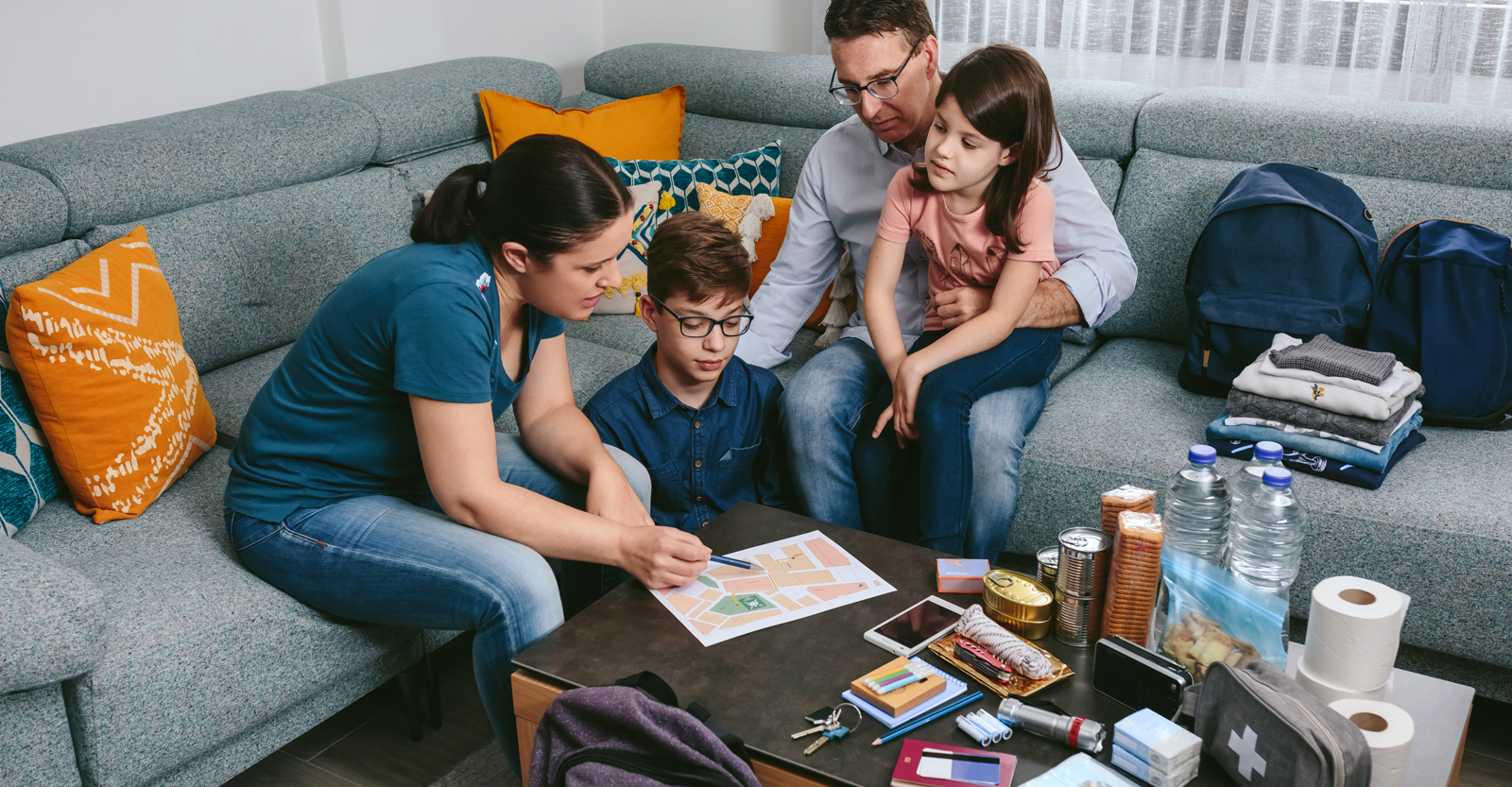
Disaster Preparedness 101: Get Ready This Disaster Preparedness Month
September 1, 2025 — Disaster insights | Homeowner insights
In an increasingly unpredictable world, disaster preparedness can help you navigate major upheavals and recover from setbacks faster.
Natural disasters, ranging from hurricanes and tornadoes to floods and wildfires, can strike with little warning, causing extensive damage, loss, and disruption. Last year, the United States experienced 27 individual weather and climate-related disasters with at least $1 billion in damages, according to Climate.gov. The total cost for these disasters was $182.7 billion, making 2024 the fourth costliest year on record. But an ounce of preparation—whether it’s building emergency kits, developing an evacuation plan, or staying informed about potential events—can greatly reduce the effects of disasters, protecting both lives and property.
Every September, FEMA’s National Preparedness Month is an opportunity to raise awareness about the importance of preparedness and to make an action plan for emergencies so you and your loved ones are ready for whatever the future may hold.
How to Prepare for a Natural Disaster
A solid disaster preparedness plan will address the most common types of disasters you may be face, how to evacuate and communicate, and what to bring. Read on to learn how to create an emergency plan, build a disaster kit, and understand the role your homeowners insurance may play in helping you recover.
Create an Emergency Plan
1. Assess Potential Risks
Consider the types of disasters most likely to affect your area, such as hurricanes, earthquakes, floods, wildfires, or tornadoes so you’ll know what to prepare for. Different disasters may require different plans—some will require you to stay put and others may require you to evacuate. Your local emergency management office or FEMA’s website can provide information on local risks.
2. Evaluate Your Home’s Vulnerabilities
- Foundation: Inspect your foundation for cracks or signs of shifting, which could make your home vulnerable during earthquakes or floods. If you notice any issues, consider consulting a professional for an assessment.
- Roofing: Check the condition of your roof. A roof in need of repair may be more likely to fail during a hurricane or high winds.
- Windows and Doors: Make sure windows and doors are properly sealed and can withstand high winds and water. Consider installing storm shutters or impact-resistant windows if you live in a hurricane-prone area.
- Landscaping: Assess the vegetation around your home. Overhanging branches can cause damage to your home during storms, and dry vegetation can increase the risk of wildfire. Trim trees and clear brush regularly.
- Drainage: Ensure that your property has proper drainage. Clogged gutters, poor grading, or inadequate drainage systems can lead to flooding and water damage.
- Utilities: Know how to shut off your home’s gas, water, and electricity in an emergency. Doing so may prevent further damage during a disaster, such as fires or water damage.
Consider following a simple home maintenance checklist to mitigate your home’s risks throughout the year.
3. Identify Safe Locations to Weather Storms
- Sheltering in Place for Tornadoes: Survey your home and work and select the safest place to wait out a tornado. Wherever you are, it’s critical to move to the lowest floor or an interior room without windows.
- Evacuating for Hurricanes or Wildfires: Familiarize yourself with your community’s evacuation levels (e.g., mandatory, voluntary) and know what each means for your situation. Identify multiple evacuation routes in case primary roads are congested or blocked. Plan how you will evacuate the area, whether it’s carpooling, public transportation, or your vehicle, and consider the needs of all household members, including pets. If your plan is to use your vehicle, be sure it is ready with plenty of fuel.
4. Designate a Meeting Location for When the Danger Passes
Identify two meeting locations: one close to your home in case of minor damage and another farther away in case the immediate area is unsafe. Avoid choosing locations that could be affected by the same disaster, such as low-lying areas prone to flooding or buildings that could be damaged in an earthquake. Make sure everyone in your household knows where the meeting spots are and how to get there. Write down the locations and keep them in your disaster kit.
5. Create a Communication Plan
Create a list of emergency contacts, including family members, neighbors, and local emergency services. Designate an out-of-town contact as a backup communication point. If your family members can’t reach the meeting spot, they can check in with this person to relay their status and location. Keep this information in your emergency kit.
6. Monitor the Weather
Sign up for local emergency alerts and weather notifications. Stay informed about potential threats and follow official advice and evacuation orders when issued.
Build a Disaster Kit
A well-prepared emergency disaster kit should include essentials to help you and your family survive for at least 72 hours. Here’s what to put in a disaster kit:
Basic Supplies
- Water: At least one gallon of water per person per day for three days for drinking and sanitation.
- Food: Non-perishable items such as canned goods, protein bars, dried fruits, and nuts. Include a manual can opener.
- Flashlight: A battery-powered or hand-crank flashlight, along with extra batteries.
- Radio: A battery-powered or hand-crank radio to stay informed, with NOAA Weather Radio if possible.
- First Aid Kit: Include bandages, antiseptics, pain relievers, prescription medications, and necessary medical supplies.
- Multitool: A multi-purpose tool with pliers, a knife, and other useful features.
- Cell Phone Charger: A portable or solar charger for your cell phone.
- Copies of Important Documents: Store copies of identification, insurance policies, bank account records, and medical information in a waterproof container.
- Cash: Small denominations of cash in case ATMs and credit card machines are unavailable.
Personal Items
- Hygiene Items: Soap, hand sanitizer, toothbrushes, toothpaste, moist towelettes, and personal hygiene products like deodorant.
- Clothing and Blankets: Extra clothes, sturdy shoes, and blankets or sleeping bags for warmth.
- Masks: N95 masks to protect against dust, smoke, or airborne contaminants.
Tools and Safety Items
- Whistle: To signal for help if you become trapped.
- Fire Extinguisher: A small, portable fire extinguisher for dealing with small fires.
- Plastic Sheeting and Duct Tape: To seal windows and doors.
Special Needs
- Infants and Children: Baby formula, diapers, bottles, and games or activities.
- Elderly or Disabled Family Members: Special medications, equipment, or dietary needs.
- Pets: Pet food, water, medication, leashes, vaccination tags or records (many evacuation shelters require them), and pet carriers or cages.
Regularly check your disaster kit to ensure items are not expired or damaged, and update it based on any changes in your family’s needs or circumstances.
Check Your Homeowners Insurance
Your homeowners insurance is designed to help you recover from disasters and setbacks, and many carriers offer coverages and services that may help you in the immediate aftermath of a disaster.
- Understand What Your Policy May Cover: Review your insurance policy to know exactly what is covered—and what isn’t. Reach out to an insurance representative if you need help. Consider the types of disasters your policy protects against and identify any coverage gaps that might leave you vulnerable. Standard homeowners policies typically do not cover floods or earthquakes while insurers in hurricane-prone areas may offer windstorm or tornado coverage as a separate policy.
- Familiarize Yourself with Additional Living Expenses Coverage: If your home is uninhabitable due to a covered disaster, additional living expenses (ALE) coverage may help cover the cost of temporary housing, meals, and other necessary living expenses while your home is being repaired. There are usually some limitations to ALE coverage, like daily limits on the amount you can claim and time restrictions on how long the benefit is available.
- Leverage Risk Mitigation Services: Your homeowners insurance company may provide services to reduce loss severity and protect your property against additional damage after a disaster. Structural, fire, and water mitigation services include removing standing water, smoke, soot, and debris like fallen trees, as well as securing the property by tarping roofs and boarding up any openings. These services are crucial for preventing further damage and beginning the recovery process quickly after a disaster. Find out if your insurance company offers these services.
- Update Your Home Inventory: Create a detailed inventory of your home’s contents that includes photos or videos. This documentation will be essential for filing insurance claims after a disaster. Do it before you need it to make the claims process even smoother.
Ready to take your disaster preparedness further? Check out more specific Get hurricane preparedness tips here.
